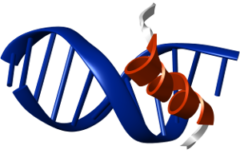3rd Structural Biology Club of the Czech Society for Structural Biology
online on
26 May 2021, 1 pm
with the following scientific talks kindly delivered by our guests:
Engineering of ancestors as a way to understand enzyme function evolution
Presented by Martin Marek, Loschmidt Laboratories, Masaryk University, Brno
Enzymes catalyse most of the chemical reactions that occur in living organisms and can be given non-natural catalytic functions by protein engineering. However, despite their vast importance, we know very little how enzymes acquire the structural diversity and conformational flexibility that enable them to evolve towards new molecular functions. Our recent data on two structurally similar but functionally distinct enzyme classes of haloalkane dehalogenases (EC 3.8.1.5) and coelenterazine-fuelled luciferases (EC 1.13.12.5) suggest that protein elements – flexible loops and access tunnels – play a pivotal role in their functional diversification. Using a multi-method approach, which combined ancestral sequence reconstruction, X-ray crystallography, HDX mass spectrometry, protein simulations and transient kinetics, we uncovered key molecular elements that favour the functional shift from hydrolytic dehalogenation to light-emitting monooxygenation (bioluminescence). Moreover, our crystal structures of Renilla-type luciferases capture unprecedented molecular details of the conformational sampling that is required for productive biocatalysis. Collectively, our results delineate the molecular basis and evolutionary trajectory leading to the emergence of bioluminescent reaction at alpha/beta-hydrolase fold enzymes. Our findings will pave the way for the creation of next-generation luciferases and luciferins exploitable in cell biology research and biosensor technologies.
Complex protein-protein interactions elucidated by NMR spectroscopy
Presented by RNDr. Mgr. Jozef Hritz, Ph.D. from CEITEC MU Brno
A wide range of protein-protein complexes involves interaction through more than a single interaction region. It is especially the case when one of the interacting partners is the intrinsically disordered protein. Solution biomolecular NMR provides detailed information about the environment of individual amino acids on atomic resolution and as NMR allows the identification of multiple areas involved in the interaction as well as the corresponding binding affinities. The combination of various NMR approaches, such as – selective labelling, experiments with a paramagnetic label (PRE/PRI experiments) or experiments in anisotropic media (RDC experiment) is often utilized to obtain a complex report on structural propensities of proteins.
Moderator: Ivana Kutá-Smatanová, Faculty of Sciences, University of South Bohemia
Please, join us on this Zoom link (join 5‐10 minutes before the beginning)
Join Zoom Meeting
https://cesnet.zoom.us/j/93844162846?pwd=TnBLWlVSQXhwTm9GS0o3QytUcE1ldz09
Meeting ID: 938 4416 2846
Passcode: 456075
